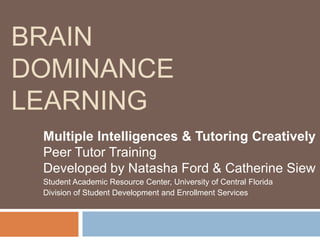
Brain Dominance Learning
- 1. BRAIN DOMINANCE LEARNING Multiple Intelligences & Tutoring Creatively Peer Tutor Training Developed by Natasha Ford & Catherine Siew Student Academic Resource Center, University of Central Florida Division of Student Development and Enrollment Services
- 2. The Brain and Dominant Learning Research indicates: the left side of the brain is the seat of language and processes in a logical and sequential order. the right side is more visual and processes intuitively, holistically, and randomly. Most people seem to have one dominant side. Image Our dominance is a Source preference, not an
- 3. Stress + Learning When learning is How this Affects new, difficult, or stressful Tutoring: we tend to PREFER to Make strides to keep learn in a certain way. stress levels down When not stressed: during tutoring The brain uses the sessions hippocampus which is Understand your important for long-term audience or students’ memory unique stressors When stressed: Be open and The brain works harder and welcoming uses a complex approach Allow a safe space for that uses a different memory system mistakes & experiments Keep it at a peer level
- 4. Brain Dominance: Left Brain Dominant Left Brain Tutoring Implications: Learning Favors: Clarity in vocabulary Language Step-by-step problem Logic solving Determine logical response Critical thinking by not giving the answer Numbers Do example problems as Reasoning well as provide general Absolutes: Facts & equations Truth Understanding the “why” behind it is important Show how to arrive at a solution
- 5. Brain Dominance: Right Brain Dominant Right Brain Tutoring Implications: Learning Favors: Familiarity/Relational Facial communication Body language Expressed emotions Professionalism Reading emotions Visuals/Organization Color Drawings/Diagrams Images Creativity Mnemonics Reading between the lines
- 6. Think-Pair-Share Discussion Learning is strengthened when we incorporate diverse learning strategies into our tutoring practice – especially from our less-dominant hemisphere Challenge! Discuss Brain Dominant Learning with a Partner: What fascinated you about what you just learned? How have you been applying modifications for various types of learners in your tutoring to date ? How will you alter your practice to incorporate brain dominance theory?
- 7. Are You a Righty or a Lefty? Complete the Brain Dominance Self-Test. Partner with an opposite brain dominant learner to complete the activity on the following slide.
- 8. Video Session Evaluations Watch one to two of the YouTube videos linked on the following slide As you watch… look for varied learning styles used in these sessions Complete the SARC Peer Tutor Observation form thinking about all components of tutoring. Focus on any modified techniques for various styles of learning that you see or don’t see in the video. Highlight what is done well?
- 9. There are MANY Learning Styles Left and Right Brain Dominance are just a few… Multiple Intelligences Information Processing Learning Styles (auditory, visual, etc.) And then some Example: Some people go with gut feelings on tests. Others write out all the steps in order to get to the right answer, paying attention to notation or punctuation. How do we explain this?
- 10. Logical vs. Intuitive Processing Processes information Use intuition in a Get right answer to linear, sequential, logic math problem, but not al manner sure how you arrived at Uses information piece answer by piece to solve Start with answer and problem work backwards When reading/listening Decisions based on look for pieces to draw feelings logical conclusions Decisions based on logical proof
- 11. Resources for Further Study Brain Dominance Hemispheric Dominance What is your Brain Dominance? Learning Styles SARC Prezi on Learning Styles Right or Left Brain? Multiple Intelligences PBS’ Overview on MI